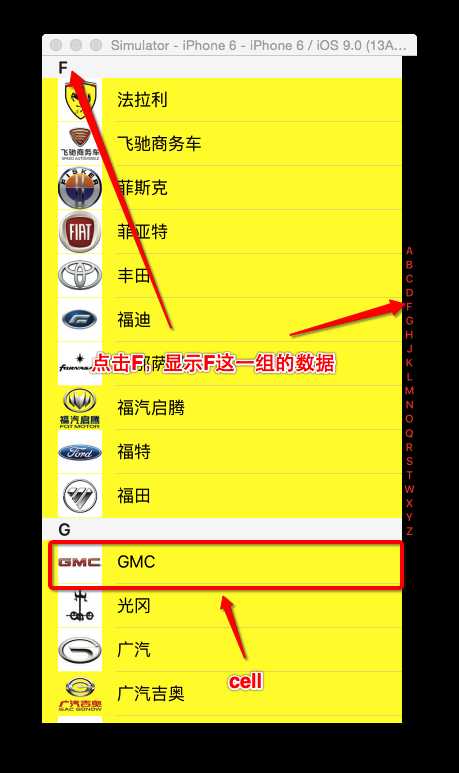标签:
在iOS中,要实现展示列表数据,最常用的做法就是使用UITableView
UITableView继承自UIScrollView,因此支持垂直滚动,而且性能极佳
UITableView的两种样式
UITableViewStylePlain
UITableViewStyleGrouped
UITableView需要一个数据源(dataSource)来显示数据
UITableView会向数据源查询一共有多少行数据以及每一行显示什么数据等
没有设置数据源的UITableView只是个空壳
凡是遵守UITableViewDataSource协议的OC对象,都可以是UITableView的数据源
tableView展示数据的过程
调用数据源的下面方法得知一共有多少组数据
- (NSInteger)numberOfSectionsInTableView:(UITableView *)tableView;
调用数据源的下面方法得知每一组有多少行数据
- (NSInteger)tableView:(UITableView *)tableView numberOfRowsInSection:(NSInteger)section;
调用数据源的下面方法得知每一行显示什么内容
- (UITableViewCell *)tableView:(UITableView *)tableView cellForRowAtIndexPath:(NSIndexPath *)indexPath;
UITableView的每一行都是一个UITableViewCell,通过dataSource的tableView:cellForRowAtIndexPath:方法来初始化每一行
UITableViewCell内部有个默认的子视图:contentView,contentView是UITableViewCell所显示内容的父视图,可显示一些辅助指示视图
辅助指示视图的作用是显示一个表示动作的图标,可以通过设置UITableViewCell的accessoryType来显示,默认是UITableViewCellAccessoryNone(不显示辅助指示视图),其他值如下:
UITableViewCellAccessoryDisclosureIndicator
UITableViewCellAccessoryDetailButton
UITableViewCellAccessoryDetailDisclosureButton
UITableViewCellAccessoryCheckmark
还可以通过cell的accessoryView属性来自定义辅助指示视图(比如往右边放一个开关)
contentView下默认有3个子视图
其中2个是UILabel(通过UITableViewCell的textLabel和detailTextLabel属性访问)
第3个是UIImageView(通过UITableViewCell的imageView属性访问)
UITableViewCell还有一个UITableViewCellStyle属性,用于决定使用contentView的哪些子视图,以及这些子视图在contentView中的位置
UITableViewCellStyleDefault
UITableViewCellStyleSubtitle
UITableViewCellStyleValue1
UITableViewCellStyleValue2
iOS设备的内存有限,如果用UITableView显示成千上万条数据,就需要成千上万个UITableViewCell对象的话,那将会耗尽iOS设备的内存。要解决该问题,需要重用UITableViewCell对象
重用原理:当滚动列表时,部分UITableViewCell会移出窗口,UITableView会将窗口外的UITableViewCell放入一个对象池中,等待重用。当UITableView要求dataSource返回UITableViewCell时,dataSource会先查看这个对象池,如果池中有未使用的UITableViewCell,dataSource会用新的数据配置这个UITableViewCell,然后返回给UITableView,重新显示到窗口中,从而避免创建新对象
还有一个非常重要的问题:有时候需要自定义UITableViewCell(用一个子类继承UITableViewCell),而且每一行用的不一定是同一种UITableViewCell,所以一个UITableView可能拥有不同类型的UITableViewCell,对象池中也会有很多不同类型的UITableViewCell,那么UITableView在重用UITableViewCell时可能会得到错误类型的UITableViewCell
解决方案:UITableViewCell有个NSString *reuseIdentifier属性,可以在初始化UITableViewCell的时候传入一个特定的字符串标识来设置reuseIdentifier(一般用UITableViewCell的类名)。当UITableView要求dataSource返回UITableViewCell时,先通过一个字符串标识到对象池中查找对应类型的UITableViewCell对象,如果有,就重用,如果没有,就传入这个字符串标识来初始化一个UITableViewCell对象
Cell的重用代码
- (UITableViewCell *)tableView:(UITableView *)tableView cellForRowAtIndexPath:(NSIndexPath *)indexPath
{
// 1.定义一个cell的标识
static NSString *ID = @”czcell";
// 2.从缓存池中取出cell
UITableViewCell *cell = [tableView dequeueReusableCellWithIdentifier:ID];
// 3.如果缓存池中没有cell
if (cell == nil) {
cell = [[UITableViewCell alloc] initWithStyle:UITableViewCellStyleSubtitle reuseIdentifier:ID];
}
1.新建一个继承自UITableViewCell的类
2.重写initWithStyle:reuseIdentifier:方法
添加所有需要显示的子控件(不需要设置子控件的数据和frame, 子控件要添加到contentView中)
进行子控件一次性的属性设置(有些属性只需要设置一次, 比如字体\固定的图片)
3.提供2个模型
数据模型: 存放文字数据\图片数据
frame模型: 存放数据模型\所有子控件的frame\cell的高度
4.cell拥有一个frame模型(不要直接拥有数据模型)
5.重写frame模型属性的setter方法: 在这个方法中设置子控件的显示数据和frame
6.frame模型数据的初始化已经采取懒加载的方式(每一个cell对应的frame模型数据只加载一次)

1 #import <UIKit/UIKit.h> 2 @interface ViewController : UITableViewController 3 @end 4 5 /*************** ViewController**********************/ 6 #import "ViewController.h" 7 #import "CarGroup.h" 8 #import "Car.h" 9 10 #define chgID @"chgCell" 11 12 @interface ViewController () 13 @property (nonatomic, copy) NSArray *cargroups; 14 @end 15 16 @implementation ViewController 17 18 - (void)viewDidLoad { 19 [super viewDidLoad]; 20 21 // 设置右边索引文字的颜色 22 self.tableView.sectionIndexColor = [UIColor redColor]; 23 24 // 设置右边索引文字的背景色 25 self.tableView.sectionIndexBackgroundColor = [UIColor blackColor]; 26 27 // 注册带有“chgCell”标识的cell 28 [self.tableView registerClass:[UITableViewCell class] forCellReuseIdentifier:chgID]; 29 30 } 31 32 // 重写cargroups的get方法 33 - (NSArray *)cargroups 34 { 35 if (nil == _cargroups) { 36 // 加载cars.plist文件 37 NSString *path = [[NSBundle mainBundle] pathForResource:@"cars" ofType:@"plist"]; 38 NSArray *carGroupsdictArray = [NSArray arrayWithContentsOfFile:path]; 39 40 41 // 创建模型数组 42 NSMutableArray *carGroupsM = [NSMutableArray array]; 43 // 字典转模型 将模型装入数组_cargroups中 44 for (NSDictionary *cardict in carGroupsdictArray) { 45 CarGroup *carg = [CarGroup carGroupWithdict:cardict]; 46 [carGroupsM addObject:carg]; 47 } 48 _cargroups = carGroupsM; 49 } 50 return _cargroups; 51 } 52 53 // 总共多少组 54 - (NSInteger)numberOfSectionsInTableView:(nonnull UITableView *)tableView 55 { 56 return self.cargroups.count; 57 } 58 59 // 每组多少行 60 - (NSInteger)tableView:(nonnull UITableView *)tableView numberOfRowsInSection:(NSInteger)section 61 { 62 return [self.cargroups[section] cars].count; 63 } 64 65 // 加载每一行的cell(cell要显示的内容) 66 - (UITableViewCell *)tableView:(nonnull UITableView *)tableView cellForRowAtIndexPath:(nonnull NSIndexPath *)indexPath 67 { 68 // 1、从缓存池获取cell 69 UITableViewCell *cell = [tableView dequeueReusableCellWithIdentifier:chgID]; 70 cell.backgroundColor = [UIColor yellowColor]; 71 // 2、如果没找到就创建一个新的cell 72 // if (nil == cell) { 73 // cell = [[UITableViewCell alloc] initWithStyle:UITableViewCellStyleDefault reuseIdentifier:ID]; 74 // } 75 76 CarGroup *carGroups = self.cargroups[indexPath.section]; 77 Car *car = carGroups.cars[indexPath.row]; 78 79 // 3、给cell赋值 80 cell.textLabel.text = car.name; 81 cell.imageView.image = [UIImage imageNamed:car.icon]; 82 83 return cell; 84 } 85 86 // 设置头部内容 87 - (NSString *)tableView:(nonnull UITableView *)tableView titleForHeaderInSection:(NSInteger)section 88 { 89 CarGroup *carGroups = self.cargroups[section]; 90 return carGroups.title; 91 } 92 93 // 设置索引条 94 - (nullable NSArray<NSString *> *)sectionIndexTitlesForTableView:(nonnull UITableView *)tableView 95 { 96 return [self.cargroups valueForKeyPath:@"title"]; 97 } 98 99 - (BOOL)prefersStatusBarHidden 100 { 101 return YES; 102 } 103 104 @end 105 106 /*************** CarGroup**********************/ 107 #import <UIKit/UIKit.h> 108 109 @interface CarGroup : UIView 110 111 @property (nonatomic, copy) NSString *title; 112 @property (nonatomic, strong) NSArray *cars; 113 114 + (instancetype)carGroupWithdict:(NSDictionary *)dict; 115 116 @end 117 118 #import "CarGroup.h" 119 #import "Car.h" 120 @implementation CarGroup 121 122 + (instancetype)carGroupWithdict:(NSDictionary *)dict 123 { 124 CarGroup *carg = [[CarGroup alloc] init]; 125 carg.title = dict[@"title"]; 126 127 NSMutableArray *arrM = [NSMutableArray array]; 128 for (NSDictionary *cardic in dict[@"cars"]) { 129 Car *car = [Car carWithDict:cardic]; 130 [arrM addObject:car]; 131 } 132 carg.cars = arrM; 133 134 return carg; 135 } 136 137 @end 138 139 140 /*************** Car**********************/ 141 #import <UIKit/UIKit.h> 142 143 @interface Car : UIView 144 145 @property (nonatomic, copy) NSString *name; 146 @property (nonatomic, copy) NSString *icon; 147 148 + (instancetype)carWithDict:(NSDictionary *)dict; 149 @end 150 151 #import "Car.h" 152 153 @implementation Car 154 155 156 + (instancetype)carWithDict:(NSDictionary *)dict 157 { 158 Car *car = [[Car alloc] init]; 159 [car setValuesForKeysWithDictionary:dict]; 160 161 return car; 162 } 163 @end
总结:待更新。。。。
IOS开发——UI进阶篇—UITableView,索引条,汽车数据展示案例
标签:
原文地址:http://www.cnblogs.com/chglog/p/4660053.html